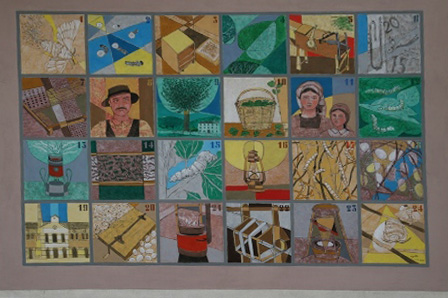Ubicazione: Colmaggiore di Sotto – Casa Mauro De Coppi
Spiegazione riquadri
Il baco da seta
Autore: Loris Giotto
Anno di realizzazione: 2010
Tecnica: Pittura Acrilica
L’allevamento del baco da seta, “Cavalier” in dialetto, rappresentava per le famiglie contadine, un modo per arrotondare le entrate e per disporre di qualche moneta sonante. Era però un’attività molto impegnativa che occupava, in particolare le donne, e che richiedeva cura attenzione e fatica.
L’opera, unica nel suo genere, è composta da 24 tasselli che rappresentano le varie fasi della lavorazione del baco: dalle uova della farfalla, all’allevamento, alla creazione del bozzolo, fino alla consegna in filanda per la produzione della seta. L’artista, in questo modo, ha voluto dare risalto ad ogni singola fase della delicata vita del baco da seta, ai vari oggetti utilizzati nella lavorazione, che in un’unica scena avrebbero perso rilevanza.
Il murales, realizzato nel 2010 da Loris Giotto di Falzè di Piave si trova in una parete di una casa a Colmaggiore dove, un tempo, tra le viti si coltivavano molti gelsi, “morer” unico alimento del baco.
Il baco da seta (The silkworm)
Location: Colmaggiore di Sotto – Mauro De Coppi’s house
Author: Loris Giotto
Year of creation: 2010
Technique: acrylic painting
Silkworm breeding farms, called “Cavalier” in venetian, were a way for farming families to top the wages and to get some ready-to-use cash. However, it was a demanding activity that required care, attention and effort and that took up mainly women.
The painting, of unique genre, is made up of 24 blocks that represent the various phases of the silkworm processing: from the eggs of the butterfly to the raising, from the creation of the cocoon to the delivery to the spinning mill for silk production. Using this method the artist wanted to highlight every single phase of the delicate life of a silkworm and to the various utensils used in processing, details that in a single scene would have lost relevance.
The painting, made in 2010 by Loris Giotto from Falzé di Piave lies on a wall of a house in Colmaggiore, where formerly many mulberries (in venetian called “morer”), the only food of the silkworms, were grown between the vines.
IL BACO DA SETA
Die Seidenraupe
Standort: Colmaggiore di Sotto – Haus Mauro De Coppi
Autor: Loris Giotto
Jahr: 2010
Technik: Acrylfarbe
Die Seidenraupenzucht, “Cavalier” im Dialekt, war für die bäuerlichen Familien ein Weg, Geld zu verdienen. Es war jedoch eine sehr anspruchsvolle Tätigkeit, insbesondere für Frauen, und benötigte Sorgfalt, Aufmerksamkeit und Mühe. Das Werk besteht aus 24 Bausteinen, die die verschiedenen Verarbeitungsschritte der Seidenraupe repräsentieren: die Eier des Schmetterlings, die Zucht, das Formen des Kokons und Lieferung in Seidenlaufwerken zur Seidenproduktion.
Der Künstler wollte jede Phase des zarten Lebens der Seidenraupe und die verschiedenen bei der Verarbeitung Gegenstände hervorheben, weil sie in einer Szene an Bedeutung verloren.
Das Wandbild befindet sich in einer Hauswand in Colmaggiore, wo viele Maulbeerbäume, einziges Futter für Seidenraupe, früher gepflanzt wurden.



